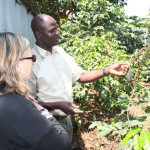SUSTAINABLE COFFEE PRODUCTION RISING
SUSTAINABLE COFFEE PRODUCTION RISING
By WORLDWATCH INSTITUTE SENIOR RESEARCHER MICHAEL RENNER
Although fluctuating from year to year, coffee production has been on an overall steady upward trend. World coffee production during the 2013/14 crop year was just slightly over 9 million tons, according to the U.S. Department of Agriculture.
 The vast majority of coffee production-more than 3 tons for every 4 tons grown-is exported, flowing from developing countries (like Brazil, Vietnam, and Colombia) principally to industrial ones. The largest consumers in 2013/14 are the European Union (consuming nearly a third of the world’s total), the United States, and Brazil.
The vast majority of coffee production-more than 3 tons for every 4 tons grown-is exported, flowing from developing countries (like Brazil, Vietnam, and Colombia) principally to industrial ones. The largest consumers in 2013/14 are the European Union (consuming nearly a third of the world’s total), the United States, and Brazil.
Coffee experiences tremendous price volatility. World market prices are set in New York and London, far from the places where coffee is grown. Because a number of developing countries depend heavily on commodities like coffee for the bulk of their export earnings, extreme price fluctuations have destabilizing impacts on their economies.
“Extreme price volatility also threatens the livelihoods of many small producers,” writes Renner. “An estimated 25 million people worldwide cultivate this labor-intensive crop, but many are small-scale producers who derive limited economic benefit compared with the traders, roasters, distributors, retailers, and investors.”
The social and environmental conditions under which coffee is produced differ widely among countries. Concerns are far-ranging, including workers’ rights and child labor, as well as the use of agrochemicals, deforestation, and impacts on biodiversity.

Co-operatives play an important role in empowering rural communities-improving their access to knowledge, inputs, and finance, as well as providing fair market access. In Ethiopia, the Oromia Coffee Farmers Cooperative Union provides important educational and health benefits for its members and has a bank providing pre-harvest financing and insurance against crop loss. In Costa Rica and India, co-operatives have become leaders in the production of carbon-neutral coffee.
Multiple initiatives have emerged that seek to define and implement more sustainable practices. The key standards are fair trade (guaranteeing a minimum price for smallholders), organic (replacing inorganic fertilizers, pesticides, and fungicides with organic ones, and often requiring coffee to be shade-grown), Utz Certified (incorporating a set of social and environmental criteria), and Rainforest Alliance (based on integrated pest management principles and including provisions for worker welfare).
In 2009, it was estimated that coffees certified as sustainable under these various initiatives represented 8% of worldwide coffee exports. Certified coffee is growing rapidly, however, and at recent growth rates could reach 20-25% of global coffee trade by 2015.

Growers will need to pay increasing attention to climate change. Rising temperatures, altered rainfall patterns, and rising pest incidence will increasingly affect future coffee production, requiring adaptation measures.
Regional Highlights from the Report:
• South America is the dominant producer of coffee and accounted for 45% of global output in 2012/13, followed by Asia (30%), Central America (13%), and Africa (11%). Asia’s share has risen dramatically from a half-century ago, when it was just 5%.
• There are two main types of coffee. Arabica beans are a sweeter and milder type grown in higher altitudes (cultivated mostly in South and Central America), whereas Robustas have a more bitter flavor and are grown in lowlands (mostly in Africa and Asia). Arabica’s once-dominant role has diminished as Asian producers have risen in importance.
• In the Netherlands, 40% of all coffee is certified sustainable; in the United States the figure is 16%.
About the Worldwatch Institute:
Worldwatch is an independent research organization based in Washington, D.C. that works on energy, resource, and environmental issues. The Institute’s State of the World report is published annually in more than a dozen languages. For more information, visit www.worldwatch.org
About Vital Signs Online:
Vital Signs Online provides business leaders, policymakers, and engaged citizens with the latest data and analysis they need to understand critical global trends. It is an interactive, subscription-based tool that provides hard data and research-based insights on the sustainability trends that are shaping our future. All of the trends include clear analysis and are placed in historical perspective, allowing you to see where the trend has come from and where it might be headed. New trends cover emerging hot topics-from global carbon emissions to green jobs-while trend updates provide the latest data and analysis for the fastest changing and most important trends today. Every trend includes full datasets and complete referencing. http://vitalsigns.worldwatch.org/
